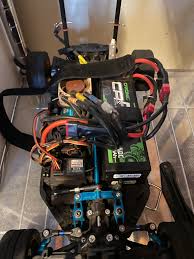DIY Tips for Customising and Maintaining Your RC Battery Straps
Remote control (RC) enthusiasts know the importance of every component in their setup, and one often overlooked aspect is the RC battery straps. These small but crucial pieces ensure your battery stays securely mounted so your RC vehicle operates smoothly and safely. Whether you’re flying a drone, driving a car, or sailing a boat, understanding how to customise and maintain your RC battery straps can significantly improve performance and extend the lifespan of your equipment. Here’s a detailed guide on how to do just that.
Understanding RC Battery Straps
Before diving into customisation and maintenance, it’s essential to understand what RC battery straps are and their function. These straps are typically made from nylon, rubber, or Velcro and are designed to hold the battery firmly during operation. The right strap reduces the risk of battery shifts or falls, which can lead to performance issues or damage.
Customising Your RC Battery Straps
1. Choosing the Right Material:
- Nylon Straps: Known for their strength and durability, nylon straps are ideal for heavier 3 cell lipo batteries typically used in larger RC models such as drones and big trucks. The material’s resilience makes it suitable for applications where the battery needs to remain secure against strong vibrations and shocks.
- Rubber Straps: Rubber straps are particularly valuable for RC models, like off-road RC cars on rough terrains. The natural elasticity and grip provided by rubber prevent the battery from sliding, thus maintaining the balance and performance of the vehicle during high-impact maneuvers.
- Velcro Straps: For those who frequently switch LIPO battery between runs, Velcro straps offer an unbeatable convenience. They allow for rapid changes without compromising the secure hold required during operation. Velcro suits competitive racing environments where time and efficiency are paramount.
2. Measuring and Cutting to Fit:
First, measure the circumference of the battery pack and the corresponding frame area on your RC model where the strap will be placed. It’s crucial to allow for a little extra length for secure overlap. Once measured, cut your strap to this specified length.
When using Velcro, it’s essential to correctly align the hook and loop sides to ensure a strong bond. Misalignment can reduce the effectiveness of the strap, increasing the risk of battery dislodgement during operation.
3. Adding Reinforcements:
To enhance the grip and prevent slippage, especially in high-movement scenarios, consider reinforcing the contact points between the strap and the battery. It can be done by sewing or gluing small patches of rubberised material to the inside of the strap where it lies against the battery. This modification can significantly stabilise the battery’s position.
4. Customising for Quick Releases:
Attach a small, brightly coloured tab or a pull made from a different material at the end of the Velcro strap. This modification helps identify the strap for quick release, particularly useful during quick maintenance sessions or battery swaps. It’s a simple tweak that can save time and improve efficiency in handling.
Maintaining Your RC Battery Straps
1. Regular Inspection:
Consistent inspection of your RC battery straps is crucial. Before and after each run, check the straps for signs of wear, such as fraying, cuts, or loosening. Immediate replacement of damaged straps is essential to maintain the safety and integrity of your RC model.
2. Proper Cleaning:
Keeping your straps clean is vital for their functionality. Dirt and debris can decrease the effectiveness of Velcro and can degrade other materials over time. Gently brush off dirt lightly and clean the straps with mild soap and water. Avoid using harsh chemicals as they can weaken the material fibres.
3. Correct Storage:
When not in use, store your RC battery straps in a cool, dry place away from direct sunlight to prevent degradation of the materials. Proper storage helps maintain the elasticity and grip of the straps, ensuring they perform well for each use.
4. Avoid Over-tightening:
While the straps must hold the battery securely, over-tightening can cause damage to both the battery casing and the strap itself. Tighten until the battery is firmly in place without compressing or distorting the strap.
5. Colour Coding for Quick Identification:
Using different coloured RC battery straps can significantly simplify the management of multiple RC models or battery types. Colour-coding your straps makes it easier to identify the correct strap for each specific model and helps quickly distinguish between different battery capacities or types. It is beneficial in environments where quick changes and correct battery pairings are crucial.
6. Incorporating Heat-Resistant Materials:
In RC models where the battery tends to heat up, such as in high-performance cars or drones, using straps made from heat-resistant materials can prevent damage. Materials such as silicone or specially treated nylon can withstand higher temperatures, ensuring the integrity and safety of your RC battery straps during and after use. This adjustment can be critical in maintaining performance and safety standards, especially during competitive or long-duration flights and drives.
7. Regular Lubrication of Attachment Points:
For RC models that utilise screws or clips in conjunction with RC battery straps for added security, regular lubrication of these attachment points can prevent rust and ensure smooth operation. A light silicone spray or a non-conductive lubricant can keep these components functioning optimally. It’s essential to avoid over-lubricating, which might attract dirt or debris, potentially interfering with the strap’s grip.
Customising and maintaining your RC battery straps that you purchased from online stores of RC Battery is a straightforward but vital part of ensuring your RC hobby is successful and enjoyable. With these tips, you can ensure that your setup is always in top shape and your batteries are secure, no matter the conditions of your operation. Remember, the longevity of your RC equipment significantly depends on how well you care for even the most minor components. So, give your RC battery straps the attention they deserve, and enjoy the optimised performance of your RC models.











